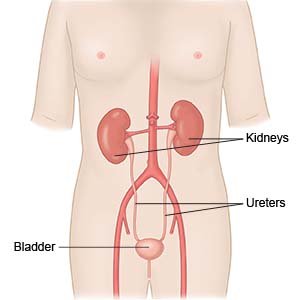Pyeloplasty for Adults
Medically reviewed by Drugs.com. Last updated on Aug 4, 2025.
Pyeloplasty is surgery to remove a blockage or narrowing between your kidney and ureter.
 |
DISCHARGE INSTRUCTIONS:
Seek care immediately if:
- You urinate less than usual or not at all.
- The incision area is red, swollen, or draining pus.
Call your doctor if:
- You have a fever.
- You have nausea or are vomiting.
- You have questions or concerns about your condition or care.
Related medications
Medicines:
You may need any of the following:
- Acetaminophen decreases pain and fever. It is available without a doctor's order. Ask how much to take and how often to take it. Follow directions. Read the labels of all other medicines you are using to see if they also contain acetaminophen, or ask your doctor or pharmacist. Acetaminophen can cause liver damage if not taken correctly.
- Antibiotics help prevent or treat a bacterial infection.
- Medicine may be given to prevent or relieve bladder spasms. This may be needed if a stent was placed during surgery.
- Take your medicine as directed. Contact your healthcare provider if you think your medicine is not helping or if you have side effects. Tell your provider if you are allergic to any medicine. Keep a list of the medicines, vitamins, and herbs you take. Include the amounts, and when and why you take them. Bring the list or the pill bottles to follow-up visits. Carry your medicine list with you in case of an emergency.
Self-care:
Your healthcare provider may give you specific instructions. The following are general guidelines:
- Rest as needed. Your provider will tell you when you can return to work, school, or other daily activities. Do not drive until your provider says it is okay.
- Drink extra liquid. Liquid will help your urinary system work properly.
- Avoid strenuous activity. Do not play sports, do vigorous exercises, or lift anything heavier than your provider says is okay. You may need to avoid these activities for 4 to 6 weeks, or as directed by your provider.
Care for the incision area as directed:
Do not let the area get wet until the surgeon says it is okay. When it is okay to bathe, do not scrub the area. Just let water run over the area. Gently pat the area dry. Then put on new, clean bandages as directed. Change your bandages when they get wet or dirty. Do not put powders or lotions over the incision area. Check the area every day for signs of infection, such as swelling, redness, or pus.
Follow up with your surgeon or doctor as directed:
Follow up within 1 week if you have a urinary catheter. If a stent was placed, your doctor will need to remove it. Ultrasound pictures will be used to check for kidney swelling or other problems. Write down your questions so you remember to ask them during your visits.
© Copyright Merative 2025 Information is for End User's use only and may not be sold, redistributed or otherwise used for commercial purposes.
The above information is an educational aid only. It is not intended as medical advice for individual conditions or treatments. Talk to your doctor, nurse or pharmacist before following any medical regimen to see if it is safe and effective for you.
Further information
Always consult your healthcare provider to ensure the information displayed on this page applies to your personal circumstances.
